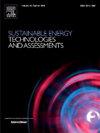Novel approaches to optimize the layouts of solar photovoltaic and wind power systems to improve their performance considering limited land availability and site-specific features
IF 7.1
2区 工程技术
Q1 ENERGY & FUELS
Sustainable Energy Technologies and Assessments
Pub Date : 2025-02-01
DOI:10.1016/j.seta.2025.104189
引用次数: 0
Abstract
Research on strategic land-use planning is crucial for successful implementation of renewable energy projects and a shift towards sustainable energy sources. The main objective of this work is to provide novel approaches to increase the energy output of solar photovoltaic (PV) and wind power systems by optimizing land utilization, while considering relevant parameters. The optimization of both technologies has been accomplished by simulations and statistical correlations. The relationships between land-use and loss of system’s configuration, energy output, installed capacity, and other factors result in an optimum architecture that considers land-use. The second objective is to explore the potential of system capacities and energy in the specific regions outlined in the 2040 Kuwait Master Plan through the implementation of these approaches. Upon implementing the approaches, the findings indicated that by utilizing the entire regions for RES, the country is limited to around 41% of its annual energy demand from RES by the year 2060. Solar PV systems exhibit maximum energy density in terms of installed capacity but possess the lowest capacity credit and energy yield compared to wind energy. It’s found that no individual technology can achieve the most favorable outcomes in terms of energy generation, capacity credit, residual load, and over-production.

优化太阳能光伏和风力发电系统布局的新方法,以提高其性能,考虑有限的土地可用性和场地特定特征
战略性土地使用规划研究对于成功实施可再生能源项目和转向可持续能源至关重要。本工作的主要目的是在考虑相关参数的情况下,通过优化土地利用,提供增加太阳能光伏(PV)和风力发电系统能量输出的新方法。通过仿真和统计相关性对两种技术进行了优化。土地利用与系统配置损失、能量输出、装机容量和其他因素之间的关系导致了考虑土地利用的最佳建筑。第二个目标是通过执行这些办法,探索《2040年科威特总计划》中概述的具体区域的系统能力和能源潜力。在实施这些方法后,研究结果表明,通过利用整个地区的可再生能源,到2060年,该国可再生能源的年能源需求将限制在41%左右。太阳能光伏系统在装机容量方面具有最大的能量密度,但与风能相比,其容量信贷和能源产量最低。研究发现,在发电量、容量信用、剩余负荷和产能过剩方面,没有哪一种技术能够达到最有利的结果。
本文章由计算机程序翻译,如有差异,请以英文原文为准。
求助全文
约1分钟内获得全文
求助全文
来源期刊

Sustainable Energy Technologies and Assessments
Energy-Renewable Energy, Sustainability and the Environment
CiteScore
12.70
自引率
12.50%
发文量
1091
期刊介绍:
Encouraging a transition to a sustainable energy future is imperative for our world. Technologies that enable this shift in various sectors like transportation, heating, and power systems are of utmost importance. Sustainable Energy Technologies and Assessments welcomes papers focusing on a range of aspects and levels of technological advancements in energy generation and utilization. The aim is to reduce the negative environmental impact associated with energy production and consumption, spanning from laboratory experiments to real-world applications in the commercial sector.
 求助内容:
求助内容: 应助结果提醒方式:
应助结果提醒方式:


